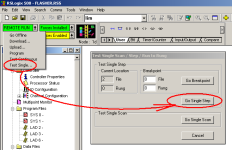JerryH
Member
When executing a FFU to unload the oldest value the data in the file is shifted down and the position value is changed. Does this shifting take place in the same scan or does it happen over multiple scans?
Jerry
Jerry
For the SLC 5/02 to 5/05, each time you trigger the FFU instruction, it unloads the oldest value in the stack (from the FIFO address). To unload 100 values, you would need to trigger your FFU 100 times. Each time you trigger the FFU, the POS indicator should decrement by 1.When executing a FFU to unload the oldest value the data in the file is shifted down and the position value is changed. Does this shifting take place in the same scan or does it happen over multiple scans?

You can Unload (FFU) in one scan if your LEN = 100 and POS = 1. If LEN = 100 and POS = 100, then it will take 100 scans. Basically the FIFO instructions can move 1 position for each scan.I'm assuming that the Fifo will update in one scan.
experiment with the idea shown below ...
You can Unload (FFU) in one scan if your LEN = 100 and POS = 1. If LEN = 100 and POS = 100, then it will take 100 scans. Basically the FIFO instructions can move 1 position for each scan.
